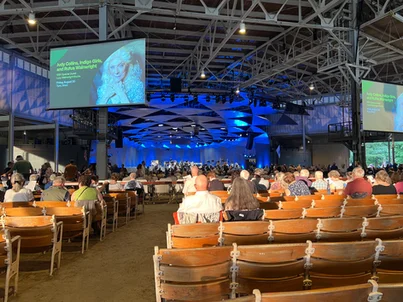On Friday night, the highly-anticipated Tanglewood season kicked off with the BSO performing an exciting all-Beethoven program featuring the Violin Concerto and Symphony No. 3 (Eroica) in the famous Koussevitzky Music Shed. The concert was led by new Head of Conducting Andris Nelsons, alongside acclaimed violinist Gil Shaham, who stepped in for Hilary Hahn after she came down with an illness.

Shaham approached the piece collaboratively, working in tandem with the orchestra rather than trying to overpower them. Whereas many soloists tend to project their sound as forcefully as possible — perhaps to show off their own skills — Shaham’s playing complimented the orchestra and vice versa. He experimented with a range of dynamics, communicating back and forth with Nelsons and the orchestra as if they were playing a duet. In the cadenza and other long solo passages, Shaham’s virtuosity and supreme technical ability were on full display, but most impressive was his ability to keep the listener constantly on their feet, playing with extraordinary passion, motion, and musicality throughout the piece.
The next day, Nelsons and Shaham hosted a Conducting Workshop at Tanglewood’s Seiji Ozawa Hall, in which they led a masterclass with two conducting students, providing a glimpse of the process of preparing a concerto. What stood out most from their approach was their commitment to collaboration and effective communication. Before the first rehearsal, they meet to go over technicalities in the score, such as pauses, fermatas, repeats, and tempo markings; in rehearsal, they constantly exchange ideas, always trying to stay on the same page and produce a cohesive sound. Indeed, at the heart of the creative process is communication, and it was that very sense of communication that came through in the concert, where the audience and musicians were so intimately bound together that it felt as though the audience was connected with the music themselves. Nelsons and Shaham were perfectly in tune throughout the Violin Concerto, making for a charming and exciting rendition of the piece.
In some parts of the first movement, Nelsons elevated the brass section, usually in passages where they played the four-note motif that carries on throughout the piece. In others, typically during solo violin passages, he restrained the orchestra to the sound of a whisper, loud enough to resonate but not too loud that it broke the trance. In the cadenza, where many violinists pound their instruments aggressively, Shaham sang the music, playing with lyricism and thoughtful musicality. His trills and ornamentations sparkled gently, flickering like one of the many stars that shone down upon the venue.
Shaham introduced many unique and intriguing ideas in his interpretation, most notably in the second movement. His playing, underlined by moving pulses in the strings, gently echoed throughout the outdoor concert hall as if he were playing a chamber piece, with many distinct lines, improvisations, and melodic touches distributed throughout.
In the transition between the second and third movements, Shaham’s skill and Nelson’s conducting were firmly put to the test as they masterfully carried out a sudden tempo change that led into the work’s finale. The third movement was played at lightning speed, and although it seemed at first like the musicians may lose each other, the performance was utterly spotless. The loudest forte of the concerto came right at the climax of the movement, a powerful progression that oscillates from the soloist to the orchestra.
As thoroughly enjoyable as the Violin Concerto was, the Eroica provided a whole other level of excitement. From the first pair of notes, which fiercely set the tone for the heroic first movement, the BSO musicians played with relentless energy. Nelsons guided the orchestra with poise and stability, allowing them to let loose without losing control. Like the Violin Concerto, the dynamics bounced quickly between soft and loud, setting up impactful climaxes.
The second movement Marcia funèbre was haunting throughout. The rhythmic pulses in the low strings sounded like heartbeats, growing stronger and weaker as the piece became more melancholic. The build-up to the first climax, roughly seven minutes into the movement, while relatively fast, was particularly effective, with the winds and low strings sounding especially round and resonant. The fugue that followed was intense but controlled, with pounding timpani rolls and booming brass blasts coming at all the right moments.
The third movement, the lightest of the symphony, was witty and fun, with pronounced back-and-forth exchanges that bounced between sections of the orchestra. The BSO horn players excelled in their impossibly difficult trio, which echoed triumphantly throughout the shed and across the lawn outside.

The fourth movement is particularly challenging to perform effectively, as it is marked by a theme-and-variation structure that, if played without fluidity and direction, can come across as dull or anticlimactic. Under Nelsons’ baton, each variation led into the next, culminating in a powerful climax and a brass-heavy finale that featured the strongest fortissimo of the evening.
All in all, this was a wonderful opening to a Tanglewood season with dozens more exciting programs to come. To learn more about the season, check out my preview of the entire festival!






